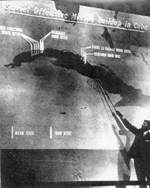The 1960's
A year after its formation, the Agency faced its first major intelligence test during the superpower confrontation that developed after Soviet missiles were discovered at bases in Cuba. Yet, even in the midst of this crisis, Agency organizational efforts continued. In late 1962, DIA established the Defense Intelligence School, and on 1 January 1963, it activated a new Production Center. Several Service elements were merged to form this production facility, which occupied the "A" and "B" Building at Arlington Hall Station, Virginia.
The Agency also added an Automated Data Processing (ADP) Center on 19 February, a Dissemination Center on 31 March, and a Scientific and Technical Intelligence Directorate on 30 April 1963. DIA assumed the staff support functions of the J-2, Joint Staff, on 1 July 1963. Two years later, on 1 July 1965, DIA accepted responsibility for the Defense Attache System--the last function the Services transferred to DIA.
JPEG
 (99.8 Kbytes)
(99.8 Kbytes)
Impetus for DIA
During these early years of DIA's existence, Agency attempts to establish itself as DoD's central military intelligence organization met with continuing Service opposition. At the same time, the Vietnam War severely tested the fledgling Agency's ability to produce accurate, timely intelligence. In particular, the war increased defense intelligence's involvement in efforts to account for American service members missing or captured in Southeast Asia.
DIA analysts focused during the 1960's on: China's detonation of an atomic bomb and the launching of its cultural revolution; increasing unrest among African nations; and, fighting in Malaysia, Cyprus, and Kashmir. In the late 1960's, crises that tested intelligence responsiveness included: the Tet offensive in Vietnam; the Six-Day War between Egypt and Israel; continuing troubles in Africa, particularly Nigeria; North Korea's seizure of the PUEBLO; and the Soviet invasion of Czechoslovakia.
 (117.0 Kbytes)
(117.0 Kbytes) (117.0 Kbytes)
(117.0 Kbytes) (99.8 Kbytes)
(99.8 Kbytes) (163.7 Kbytes)
(163.7 Kbytes)